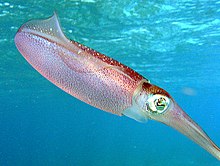Lophotrochozoa
 Vikipedi, özgür ansiklopedi
Vikipedi, özgür ansiklopedi
| Lophotrochozoa | |||||||
|---|---|---|---|---|---|---|---|
 Karayip resif kalamarı veya Sepioteuthis sepioidea, kompleks bir lophotrochozoa | |||||||
| Biyolojik sınıflandırma | |||||||
| |||||||
| Phyla | |||||||
| Lophotrochozoa geçici aralık: | |
|---|---|
 | |
| Karayip resif kalamarı veya Sepioteuthis sepioidea | |
| Bilimsel sınıflama | |
| Kingdom: | Animalia |
| Subkingdom: | Eumetazoa |
| Clade: | ParaHoxozoa |
| Clade: | Bilateria |
| Clade: | Nephrozoa |
| (unranked): | Protostomia |
| (unranked): | Spiralia |
| Superphylum: | Lophotrochozoa Halanych et al., 1995 |
| Phyla | |
| |
Lophotrochozoa, Spiralia'daki bir protostom hayvan sınıfıdır. Taksonu moleküler kanıtlara dayalı olarak monofiletik bir grup olarak kurulmuştur.[2][3] Sınıf: annelidler, yumuşakçalar, bryozoanlar, brachiopodlar ve platyhelminthes gibi hayvanları içerir.[4]
Gruplar
[değiştir | kaynağı değiştir]Lophotrochozoa üst şubesi, bazal Cycliophora ve Mollusca gruplarına ve türetilmiş olan Lophophorate, Nemertea ve Annelida gruplarına sahiptir.[5][6]
Platytrochozoa ve Rouphozoa'nın tanıtılmasıyla birlikte bir filogenisi aşağıda resmedilmiştir - ancak diğer çalışmalar bir dizi alternatif olasılığı ortaya çıkarmaktadır:[7][8][9][10][11][12][13][14]
| ||||||||||||||||||||||||||||||||||||||||||||||||||||||||||||||||||||||||||||||||||||||||
Başka bir çalışma Lophotrochozoa'yı Platytrochozoa'ya eşdeğer olarak görür ve Spiralia'nın tabanında Gnathifera ile bir kardeş grup oluşturur.[15]
Özellikler
[değiştir | kaynağı değiştir]Lophotrochozoa sınıfı adını üyelerinin iki farklı özelliğinden almıştır; lophophore, bir ağzı çevreleyen kirpikli dokunaç taçlarından oluşan bir beslenme yapısı ve trochophore larvasının gelişim aşaması. Brachiozoa ve Bryozoa gibi Lophophorata'da lophophores bulunurken, Trochozoa'nın yumuşakçalar ve annelidler gibi üyelerinde trochophore larvaları bulunur. Ancak bazılarında hiç olmayabilir.[16][17]
Kaynakça
[değiştir | kaynağı değiştir]- ^ Budd, Graham E.; Jackson, Illiam S. C. (January 5, 2016). "Ecological innovations in the Cambrian and the origins of the crown group phyla" 21 Ekim 2022 tarihinde Wayback Machine sitesinde arşivlendi.. Philosophical Transactions of the Royal Society B: Biological Sciences. 371 (1685): 20150287. doi:10.1098/rstb.2015.0287. PMC 4685591 21 Ekim 2022 tarihinde Wayback Machine sitesinde arşivlendi.. PMID 26598735 17 Ekim 2022 tarihinde Wayback Machine sitesinde arşivlendi..
- ^ Halanych, K. M., Bacheller, J., Liva, S., Aguinaldo, A. A., Hillis, D. M. and Lake, J. A. (17 Mart 1995). "18S rDNA evidence that the Lophophorates are Protostome Animals". Science. 267 (5204): 1641-1643. doi:10.1126/science.7886451. PMID 7886451.
- ^ Hervé (May 2005). "Multigene Analyses of Bilaterian Animals Corroborate the Monophyly of Ecdysozoa, Lophotrochozoa, and Protostomia". Molecular Biology and Evolution. 22 (5): 1246-1253. doi:10.1093/molbev/msi111. PMID 15703236.
- ^ Kliman, Richard M., (Ed.) (1 Ocak 2016), "Lophotrochozoa, Diversification of", Encyclopedia of Evolutionary Biology, Oxford: Academic Press, ss. 405-408, doi:10.1016/b978-0-12-800049-6.00272-9, ISBN 978-0-12-800426-5, 25 Mart 2022 tarihinde kaynağından arşivlendi, erişim tarihi: 14 Şubat 2021 Yazar
|ad1=eksik|soyadı1=(yardım) - ^ Nesnidal (2013). "New phylogenomic data support the monophyly of Lophophorata and an Ectoproct-Phoronid clade and indicate that Polyzoa and Kryptrochozoa are caused by systematic bias". BMC Evolutionary Biology. 13 (1): 253. doi:10.1186/1471-2148-13-253. PMC 4225663 $2. PMID 24238092.
- ^ Laumer (August 2015). "Spiralian Phylogeny Informs the Evolution of Microscopic Lineages". Current Biology. 25 (15): 2000-2006. doi:10.1016/j.cub.2015.06.068. PMID 26212884.
- ^ Paps (1 Ekim 2009). "Bilaterian Phylogeny: A Broad Sampling of 13 Nuclear Genes Provides a New Lophotrochozoa Phylogeny and Supports a Paraphyletic Basal Acoelomorpha". Molecular Biology and Evolution. 26 (10): 2397-2406. doi:10.1093/molbev/msp150. PMID 19602542.
- ^ Struck (5 Nisan 2007). "Annelid phylogeny and the status of Sipuncula and Echiura". BMC Evolutionary Biology. 7 (1): 57. doi:10.1186/1471-2148-7-57. PMC 1855331 $2. PMID 17411434.
- ^ Hausdorf (1 Aralık 2007). "Spiralian Phylogenomics Supports the Resurrection of Bryozoa Comprising Ectoprocta and Entoprocta". Molecular Biology and Evolution. 24 (12): 2723-2729. doi:10.1093/molbev/msm214. PMID 17921486.
- ^ Struck (July 2014). "Platyzoan Paraphyly Based on Phylogenomic Data Supports a Noncoelomate Ancestry of Spiralia". Molecular Biology and Evolution. 31 (7): 1833-1849. doi:10.1093/molbev/msu143. PMID 24748651.
- ^ "cycliophorans". Encyclopedia of Life. 26 Kasım 2015 tarihinde kaynağından arşivlendi.
- ^ Lu (29 Mayıs 2017). "The phylogenetic position of dicyemid mesozoans offers insights into spiralian evolution". Zoological Letters. 3 (1): 6. doi:10.1186/s40851-017-0068-5. PMC 5447306 $2. PMID 28560048.
- ^ Temereva (31 Temmuz 2017). "The first data on the innervation of the lophophore in the rhynchonelliform brachiopod Hemithiris psittacea: what is the ground pattern of the lophophore in lophophorates?". BMC Evolutionary Biology. 17 (1): 172. doi:10.1186/s12862-017-1029-5. PMC 5537927 $2. PMID 28760135.
- ^ Luo (4 Aralık 2017). "Nemertean and phoronid genomes reveal lophotrochozoan evolution and the origin of bilaterian heads". Nature Ecology & Evolution. 2 (1): 141-151. doi:10.1038/s41559-017-0389-y. PMID 29203924.
- ^ Marlétaz (10 Ocak 2019). "A New Spiralian Phylogeny Places the Enigmatic Arrow Worms among Gnathiferans". Current Biology. 29 (2): 312-318.e3. doi:10.1016/j.cub.2018.11.042. ISSN 0960-9822. PMID 30639106.
- ^ Invertebrate Zoology. 1982. ss. 200-206. ISBN 978-0-03-056747-6. OCLC 1015202568.
- ^ Campbell Biology. Berkeley, California: Pearson. 2013. s. 688. ISBN 978-0-321-77565-8.
Ek okuma
[değiştir | kaynağı değiştir] Wikimedia Commons'ta Lophotrochozoa ile ilgili çoklu ortam belgeleri bulunur
Wikimedia Commons'ta Lophotrochozoa ile ilgili çoklu ortam belgeleri bulunur Vikitür'de Lophotrochozoa ile ilgili ayrıntılı taksonomik bilgiler bulunur.
Vikitür'de Lophotrochozoa ile ilgili ayrıntılı taksonomik bilgiler bulunur.- Podsiadlowski (2009). "Phylogeny and mitochondrial gene order variation in Lophotrochozoa in the light of new mitogenomic data from Nemertea". BMC Genomics. 10 (1): 364. doi:10.1186/1471-2164-10-364. PMC 2728741 $2. PMID 19660126.

